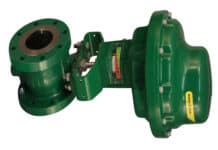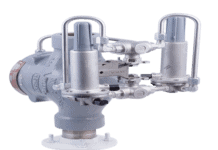By Katrina Krites
From the February 2023 Issue
Historically, refrigerant leak detection has been an essential component of commercial refrigeration system design. In traditional centralized direct expansion (DX) systems that use hydrofluorocarbon (HFC) refrigerants, reducing leaks is considered important for multiple reasons, including safety. Simply put, staying below acceptable refrigerant concentration limits (RCLs) is necessary to meet Occupational Safety and Health Administration (OSHA) exposure limit regulations in numerous applications.

Better early detection and reduction of refrigerant leaks also helps to limit system downtime, reduce maintenance spend, and avoid unnecessary refrigerant costs—which have fluctuated significantly in recent years. It’s widely accepted that non-leaking systems deliver maximum system performance and improved efficiencies.
Over the past few decades, refrigerant leaks also have been identified as potential threats to the environment. In addition to ensuring safe operation, today there are global regulatory efforts to minimize carbon emissions from systems that potentially leak or release high-global warming potential (GWP) HFC refrigerants.
As the commercial refrigeration industry transitions to refrigerants below 150 GWP, such as those required to meet the California Air Resources Board (CARB) regulation, many newly approved refrigerants will have a degree of flammability. Offering a range of low-GWP ratings, mildly flammable A2L refrigerants have been identified as viable alternatives for complying with emerging refrigerant regulations. But they must be used properly in settings with adequate leak detection capabilities.
This is not the first time flammable refrigerants will play a role in commercial refrigeration. Today, R-290 (aka propane)—which has a higher flammability A3 classification—is commonly used in self-contained reach-ins and display cases.
Regulatory efforts to approve new A2L refrigerants in the U.S. are currently underway and expected to be finalized over the next few years. As A2L refrigerants become more commonplace, system architectures utilizing specific leak detection strategies will be necessary to mitigate the potential for flammability and ensure operational safety.
Charge Limits
Because of the potential flammability of A2L refrigerants, current equipment safety standards have limited their use to relatively small refrigeration architectures, such as: self-contained systems, indoor/outdoor condensing units, and distributed systems.
A2L refrigerants are subject to refrigerant-specific charge limits based on the lower flammability limit (LFL) of each refrigerant. These are among the first of many mitigation strategies when using flammable refrigerants.
Per a recent update to the second edition of the UL 60335-2-89 safety standard, A2L charge limit guidelines have been established for self-contained and remote refrigeration systems. For cases, charge limits are determined based on whether equipment has an open design (without doors) or a closed design (with doors or drawers).
For example, since R-454C has an LFL of 0.291 kg/m3:
- A closed-door case can be charged with up to 2.33 kg (5.1 lbs.) of R-454C.
- An open case with R-454C can be charged with up to 3.78 kg (8.3 lbs.) of R-454C. In remote or field-erected systems, UL 60335 2-89 supports R-454C charge sizes up to 75.7 kg (166 lbs.) per circuit.
Safety Strategies For Remote Systems
Installing remote systems with A2L refrigerants requires the use of safety strategies and mitigation measures to keep gas concentrations below flammable thresholds. Per the UL 60335 2-89 standard, A2L systems must be designed to detect refrigerant leaks at various points of the refrigeration circuit—from the compressor to the condensing unit to the case—and then take immediate action to mitigate flammability risks.
Specific charge calculations and mitigation methods are based on the flammability rating of the A2L and the size, location, and type of application (i.e., walk-in unit or display case and the room in which it is located). It’s important to note that this calculation will also determine the allowable releasable charge limit, which is the amount that can safely be released prior to shut off and activation of isolation valves.
Common safety strategies rely on a combination of detection and mitigation technologies where appropriate:
- Leak detection and safety shut-off valves to limit releasable charge
- Air circulation fans and/or ventilation strategies
- Integrated system controls with A2L logic
A2L Leak Detection Solutions
There are a full range of leak detection sensors, valves, and controls available for A2L refrigeration systems. Some refrigerant leak detection sensors (RLDS) are designed to sense many emerging A2L options, and are able to fully integrated to building management system (BMS) or connect to mobile apps.
In the event of a leak, advanced electronic controls at the system, case, and building levels, are capable of performing required actions in the event of a leak—such as shutting off the compressor and other components or activating shut-off/isolation valves. Some systems are able to notify facility managers and executives about leaks in real time, enabling them to respond quickly. In addition, technology can detect the potential for leaks and take preventative actions before they occur.
As the U.S. refrigerant transition accelerates over the next few years, A2L refrigerant options will become increasingly viable alternatives to higher-GWP HFCs. Due to their potential flammability, leak detection and integrated safety technologies will be required on many A2L systems as a form of mitigation.
Regulations Support Wider A2L Adoption
The UL 60335 2-89 update is the first of several regulatory approvals needed to enable the broader use of A2L refrigerants in U.S. commercial refrigeration. Look for the following supporting legislation to be passed in the coming months and years:
- Environmental Protection Agency (EPA) Significant New Alternatives Policy (SNAP) approval of specific A2L refrigerants
- American Society of Heating, Refrigeration, and Air-Conditioning Engineers (ASHRAE) 15 safety standard update for refrigeration systems
- Model Code updates in the upcoming code revision cycle
- State and local building code updates
Industry experts expect to see A2L adoption to increase significantly as these regulatory milestones are passed. In the meantime, A2L-based refrigeration will require the approval of local authorities having jurisdiction, such as fire marshals and/or building inspectors.
In addition to the CARB proposal that calls for the use of refrigerants below the 150 GWP, the American Innovation and Manufacturing (AIM) Act is proposing regulations which will favor the use of lower-GWP refrigerants. A2Ls are among the few refrigerants capable of meeting these regulatory thresholds. ♦
 Krites is the Director of Strategic Marketing, Cold Chain for Emerson. Her responsibilities encompass the strategic marketing of Emerson’s major market segments of cold chain including food retail, food service, and healthcare. These responsibilities include, but are not limited to: setting and implementing growth strategies; understanding market trends and dynamics in order to prioritize key initiatives within product development; and implementing go-to-market strategies.
Krites is the Director of Strategic Marketing, Cold Chain for Emerson. Her responsibilities encompass the strategic marketing of Emerson’s major market segments of cold chain including food retail, food service, and healthcare. These responsibilities include, but are not limited to: setting and implementing growth strategies; understanding market trends and dynamics in order to prioritize key initiatives within product development; and implementing go-to-market strategies.
Do you have a comment? Share your thoughts in the Comments section below, or send an e-mail to the Editor at jen@groupc.com.
A2L Flammability Characteristics
Understanding the flammability characteristics of specific A2L refrigerants is essential for evaluating safety considerations, calculating charge limits, and determining their relative risks. The A2L classification of mildly flammable becomes more apparent when compared to R-290 (propane). Consider the following key flammability metrics:
- Lower/upper flammability limits (LFLs/UFLs)—The LFL of A2Ls is roughly eight times higher than R-290. As a result of its lower flammability limit, there are fewer concerns about it becoming concentrated and at risk of igniting, allowing for potentially larger charge sizes in higher-capacity applications.
- Minimum ignition energy (MIE)—R-290 has a very low MIE, and as such can be more easily ignited by lower energy sources such as static electrical discharge. A2L MIEs are significantly higher, typically requiring an open flame or strong electrical energy source to sustain an ignition.
- Burning velocity (Su) and heat of combustion (HOC)—Su and HOC are much lower in A2Ls than R-290, resulting in a much lower severity of ignition events. These factors must be considered when determining both charge sizes and releasable charge limits for A2L applications.



















![[VIDEO] Collect Asset Data at the Speed of Walking a Building](https://facilityexecutive.com/wp-content/uploads/2024/02/maxresdefault-324x160.jpg)